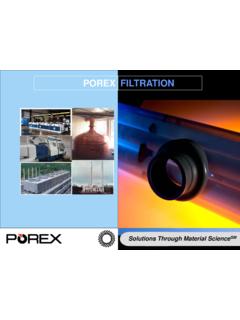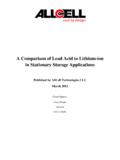Transcription of Basic Ion Exchange and Applications - IFM
1 Basic Ion Exchange and Applications Bill Koebel North East Technical RepResinTech, , Inc. Bill Koebel Northeast Regional Sales Manager Ion Exchange Resins and Activated Carbon Experts in water and wastewater ion Exchange applicationsResinTech History Founded in 1986 Located in West Berlin, NJ Processing plant Laboratories Sales & Marketing Warehousing Other Warehouses Florida Texas CaliforniaResinTech Services Technical Resin Rating Projections Laboratory analysis Resin selection Troubleshooting Comprehensive website People All sales staff technical experts Available by phone, fax, or email for immediate assistanceApplications Pharmaceutical Semiconductor Textile Automotive Electroplating Beverage Hemodialysis Pulp & Paper Nuclear Power Aquaculture Laboratory Portable Exchange Residential EDM Remediation MunicipalTopics of Discussion History How resins are made Basic Terminology Ion Exchange Process Resin Types Basic Applications Q & AEarly Ion Exchange History Desalting of brackish waters mentioned in.
2 The Bible & Ancient Greeks Sir Francis Bacon 1850 - Thompson & Way report to Royal Agriculture Society Exchange of ions in soil Attributed to aluminum silicates 1858 - Eichorn proves reaction is reversibleSynthetic Exchangers 1905 - Gans develops synthetic exchanger Called Zeolites, from Greek words Zeinand Lithos 1913 - First synthetic zeolites marketed in America 1944 - D Alelio develops cation exchanger based on styrene/DVB copolymer 1948 - Anion exchanger developedIon Exchange Today Tiny plastic beads that have been chemically activated They are manufactured products that are made from petrochemical based monomersMake the Beads Styrene DiVinyl Benzene (Crosslinkage) Suspension Polymerization No Water Content Neither Cation or Anion resin Beads are called co-polymer Functionalized to an Ion Exchange resinMaterial Properties Size between 16 to 50 Mesh Resistance to fracture Insoluble Permanently attached sites High capacity for ions Temperature effects negligibleWhat is Ion Exchange ?
3 Exchange of undesirable ions for desirable ones Selectivity drives the reaction The process is reversible via regenerationDefinition of Ions Cations Positively charged ions dissolved in solution Anions Negatively charged ions dissolved in solution Law of Electroneutrality In any solution the number of cations equals the number of anionsBasic Products Cation Resins Anion Resins Mixed Bed Resins Selective Resins & ZeolitesCation Resins Used to remove cations from water Hardness, Heavy Metals or all cations Strong Acid Cation Typically use Na+or H+forms Weak Acid Cation Typically use Na+or H+formsCommon CationsIronFe2+CalciumCa2+MagnesiumMg2+S odiumNa+PotassiumK +HydrogenH +Anion Resins Used to remove anions from water Complexes, oxy anions (Cromate, Sulfate, etc.)
4 Strong Base Anion Typically use Cl-or OH-forms Weak Base Anion Typically use Cl-or free base formsCommon AnionsPhosphatePO4-3 SulfateSO4-2 NitrateNO3-ChlorideCl -BicarbonateHCO3-HydroxideOH-Selective Resins & Media Used to remove various ions from water Heavy metals most common Chelating Resins Typically use Na+or H+forms Many typesIon Exchange Processes Softening Dealkalization Deionization Nitrate removal Condensate polishing Pollution controlSelectivity The attraction, of one ion over another, to an ion Exchange resin Function of ion charge, size and concentration For SACs and SBAs: Bigger the ion, higher the charge, the more selective the ion becomes -3>-2>-1 and +3>+2>+1 Inside the Resin BeadPS-DVB Resin bead Crosslinks betweenpolymer chains (DVB)Polymer chains(polystyrene- PS)--------Functional siteson polymerInside the Resin Bead+-+++---Functional sitesshown occupied by regenerant ions ( H+)Inside the Resin Bead+-+++---Watercontactsresin beads.
5 Beadsare ~50% Resin Bead in Action+-+++---Water containing unwanted ions, in contact with water inside beads, allows ions todiffuse in/out of Resin Bead in Action----Calciumions enterCa+2++++Ca+2 Hydrogenions are exchanged and exit producingimproved waterThe Resin Bead in ActionIon Exchange - High Purity WaterA----------++++++++H +H +H +H +OH_OH_OH_OH_OH_OH_SO42-HCO3-Cl-Ca2+Na +Mg2+H +CIon Exchange - High Purity WaterA----------++++++++H +H +H +H +OH_OH_OH_OH_OH_OH_SO42-HCO3-Cl-Ca2+Na +Mg2+H +CIon Exchange - High Purity WaterA----------++++++++H +H +H +OH_OH_OH_SO42-HCO3-Cl-Ca2+Na +Mg2+CHOH(-)(+)HOH(-)(+)Definition Chelating ResinChela:Gr. The pincer like claw(s) of a crab, lobster, or : The chemical term for an electron pair donor (Lewis base) when it forms a bond with a metal caChelating Resin:Ion Exchange resins that have ligands that can bon with metal cations.
6 The ligands may be in additio to or in place of conventional ion Exchange :The preference of an ion Exchange material fora particular ion. Selectivity is always relative toa particular operating LobsterChelaFishLobsterChelating & Selective Resins True Chelating Resins Iminodiacetate (SIR-300) Aminophosphonic (SIR-500) Picolyamine (SIR-1000) Selective Resins Thiol (SIR-200) Thiouronium (SIR-400) Exhausted Weak Base (WBMP & SIR-700) Natural Zeolites (SIR-600, greensand, & others) Weak Acid Cation Resins (WACG & WACMP) Nitrate & Perchlorate Selective (SIR-100 & SIR-110)What Makes a Chelating Resin Selective? Ionic Charge (Valence) Most chelating resins prefer di-valent ions to mono-valent or tri-valent ions, because the chelant group has two Chela (claws).
7 Hydrated Ionic Radius When the size of the hydrated radius of the ion closely fits the space between the Chela the resin is very selective for that particular ion. Ligand Bonding Nitrogen (and oxygen) can possess an exposed electron pair, making them Lewis bases (electron pair donors). Metals that are Lewis acids form ligands with Lewis Chelant SIR-300 CH CH2CH2 NCOOCH2CH2 COOCu++Sodium Form (unstable charge balancCopper Form (very stable charge balanCH CH2CH2 NCOOCH2CH2 COONa++NaLigand bondingIminodiacetate Chelant (SIR-300)Operating Limits Dissolved Solids Unaffected by Sodium and other Group 1A metals (except hydrogen) Practically unaffected by Calcium and other Group 2A metals Selectivity is affected by other complexing agents EDTA blocks Exchange entirely for many metals Ammonia affects Exchange significantly Chloride has a minor effect on selectivity pH Optimum pH is usually slightly acidic Selectivity is lower at high pH Loses selectivity below pH of Chelant (SIR-300)Criteria for Selection Removal of divalent Group IV (transition) metals High TDS background (greater than 1000 ppm) Significant calcium concentration present (equal to or greater than the metal concentration) pH is slightly acidic (optimum pH is approx.)))
8 4)Capacity of SIR-300 Various Metals (at saturation)012345012345inlet pHCapacity (lbs metal/ cuft)CopperNickelIronTDS Limits of various ResinsUsed for Metals Removal Strong Cation Resin (Hydrogen form)500 ppm Strong Cation Resin (Sodium form)1,000 ppm Weak Cation Resin (Sodium form)10,000 ppm Chelating Cation Resin (Sodium form)no limit Mixed Bed Resin500 ppmWhat do we need to Know? Viability of ion Exchange TDS (or conductivity) with min and max if variable pH and Temperature with min and max if variable Basic inorganic analysis of ions (Ca, Mg, Na, Cl, SO4) presence or absence of oxidants presence or absence of complexing agents level and type of organic molecules level of suspended solidsDefinitions PPM (mg/l) Parts per Million (milligrams per liter) a measure of the concentration of ions as defined by their weight as CaCO3 A measure of the concentrations of ions based on the number of ionic charges.
9 Grains a very small unit of weight, originally equal to a grain of Factors 7000 grains = 1 pound PPM (as CaCO3) = 1 grain per gallon gallons = 1 cubic foot 40% = resin void volumeResin Selection Feedwater analysis Desired effluent quality Operating conditions Economics Type of equipment Regeneration chemicals availableTypical Resin Life Operating Life Cation 8 to 10 years Anion 4 to 6 years Factors Oxidants Temperature Regeneration frequencyFactors Affecting Resin Performance Oxidation Chlorine Temperature Loss of capacity Fouling Organic Oil Loss of resin Backwash lossEquipment Troubleshooting Equipment Failure Distribution Problems Control malfunctions Operator error Changing Water analysisTypes of Waste Treated Rinse Waters Acid and neutral Rinses Alkaline cyanide Rinses EDM
10 Machines PCB washers Plating Baths Tri chrome Wastewater End of pipe polishingTypical Plating Rinse Tank Set-upPlatingBathDeadRinseFirstRinseSeco ndRinseFinalRinseIX ColumnsPre-filterSumpMisc Ion Exchange Possibilities Silver (and other precious metals) Lead (and other heavy metals) pH control (by ion Exchange buffering) Fluoborate (and other exotic ions) Carbonate Removal (from cyanide baths)Bulk Regeneration for base transition metals pH Adjustment Carbamate precipitation Filter Press Final Filtration Ion Exchange PolishingBulk Waste Treatment SchematicIon ExchangeColumnsPre-filterFilter PressMixTankWaste InletFinalwasteTankAcidCausticPolymerCar bamateRegeneration Sequence Backwash Chemical Injection Displacement / Slow rinse Fast RinseBackwash A flow of water is passed upward through the resin bed The resin bed expands and fluidizes Suspended solids are removed The resin bed is classified.




